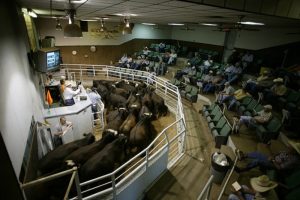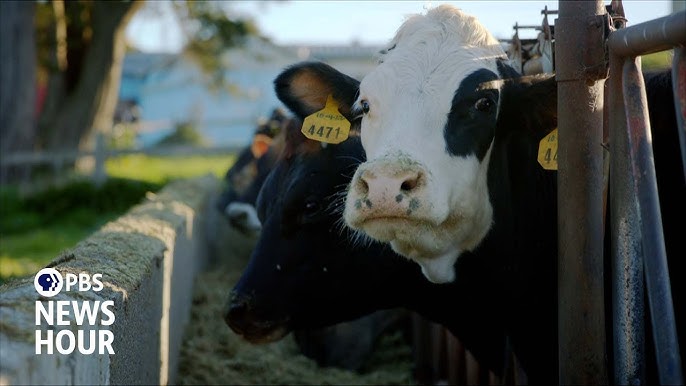William Brangham:


Science correspondent Miles O’Brien traveled from California to Mexico and Australia to explore a bold idea that could make a big impact. It’s part of our series, Tipping Point.
Notice: Transcripts are machine and human generated and lightly edited for accuracy. They may contain errors.
William Brangham:
In the ongoing effort to curb climate change, scientists are taking aim at a surprisingly potent source of the greenhouse gases that are warming our planet, cows.
As part of our Tipping Point series, science correspondent Miles O’Brien traveled from California to Mexico and even to Australia to explore a bold idea that could make a big impact.
Miles O’Brien:
It’s 0 dark 30 at the Straus Dairy Farm in Marin County, California. The cows stand patiently in line, ready for the morning milking. At the helm is Albert Straus.
Albert Straus, Straus Family Creamery:
I want to make a farming system that’s a positive impact on the environment, at the same time produce high-quality organic food.
Miles O’Brien:
So methane is never far from his mind. It’s an especially potent greenhouse gas. Over 20 years, it traps about 80 times more heat than carbon dioxide. Dairy cows and beef cattle emit a significant amount of it. It mostly comes from their burps, not flatulence.
In fact, methane emissions from livestock exceed the oil and gas industry. It’s a stubborn problem. And, for Albert, it threatens to derail his goal of achieving carbon neutrality by 2030.
Albert Straus:
Cows have an essential role in reversing climate change.
Miles O’Brien:
That’s why, in 2021, he jumped at the chance to become the first commercial dairy in the U.S. to test a novel methane mitigation solution, seaweed in the feed. He enrolled two dozen cows in a two-month trial.
Albert Straus:
The things that we were testing for didn’t have any effects on animal health or human health. There was no off-flavors or effects on the quality of the milk or the quantity of the milk.
Miles O’Brien:
The additive comes from a red seaweed called asparagopsis taxiformis. It was less than a half-a-percent of the cows’ diet, but the results were dramatic.
Albert Straus:
An average of 52 percent reduction, with some cows over 80 percent, and then one cow over 90 percent.
Miles O’Brien:
University of California Davis animal University of California Davis animal scientist Ermias Kebreab consulted on the study. He is a world leader in the quest to cut methane emissions from livestock.
Ermias Kebreab, University of California, Davis: I think we can produce high-quality protein, high-quality milk, at the same time help the planet.
Miles O’Brien:
To gather data on how much methane a cow might be exhaling, they use a device called GreenFeed. As the cows lick, chew, breathe, and belch, the gases they exhale are sucked into a tube for real-time analysis.
Ermias Kebreab:
So it will analyze the contents of the breath in different concentrations of the gases.
Miles O’Brien:
Hello. How are you. How are you?
They are recording impressive results. Cows that consume just a quarter of 1 percent seaweed in their diet emit 30 percent less methane.
Ermias Kebreab:
We are kind of slowly introducing the higher dose now.
Miles O’Brien:
What do you think the upward limit is?
Ermias Kebreab:
In the literature, there is a report that 98 percent reduction.
Miles O’Brien:
Ninety-eight?
Ermias Kebreab:
Ninety-eight percent reduction. Ourselves, we’ve seen about 80 percent.
Miles O’Brien:
And that’s with only one-half of 1 percent seaweed additive. So, why do cows produce so much methane? To understand that, we need to ruminate literally on the rumen, the first of four compartments in a cows stomach. Here, microbes start the whole process of turning grass into energy.
But this fermentation also releases carbon dioxide, CO2, and hydrogen, H2. With the help of a special enzyme, those molecules are converted to methane, CH4, and exhaled. But this process can be disrupted by an ingredient in seaweed called bromoform. It disables that enzyme, preventing the CO2 and H2 from forming methane.
And the hydrogen is now for the cow. Effective as it appears to be, a lot of it needs to be grown to make a dent in livestock methane production. That’s what they are working on here in Mexico, 140 miles south of San Diego in the tiny community of Ejido Erendira. The U.S. start-up that performed the study at the Straus Dairy Farm is shifting into large-scale production.
This is the Blue Ocean Barns seaweed farm.
Hannah Resetarits, Blue Ocean Barns:
So this is called the sun tube.
Miles O’Brien:
The senior manager of operations expansion, Hannah Resetarits, gave me a tour.
Hannah Resetarits:
All of our cultures start in this room and then scale outside all the way up through our different vessel sizes.
Miles O’Brien:
Outdoors, they scale up in 17,000-gallon shallow vessels. Scientists are still learning what the seaweed likes and what it doesn’t.
You’re trying to scale up and still understand some basic science at the same time, which is a challenge, right?
Hannah Resetarits:
Oh, 100 percent, yes. It is something that makes this job very exciting. It also means that, as we go, we are also going back and improving our systems every day.
Miles O’Brien:
Joan Salwen is the co-founder and CEO of Blue Ocean Barns.
Joan Salwen, Co-Founder and CEO, Blue Ocean Barns: It became clear that this kind of finicky seaweed was not just going to become domesticated without a little bit of a fight.
Miles O’Brien:
The company has raised $35 million. It is in talks with some major food producers, scrambling for ways to meet carbon neutrality targets.
Joan Salwen:
Not one of them will get to carbon neutral without our product. And if they continue to feel pressure to make good on their promise, I feel very, very bullish.
Miles O’Brien:
Nice one.
But she does face a serious roadblock. In the U.S., the Food and Drug Administration has no category for products aimed at reducing greenhouse gases. If bromoform from seaweed is considered a veterinary drug, the approval process might take five to 10 years, far too long, given the urgency of the climate crisis.
Joan Salwen:
We’re a little stuck in the United States.
Miles O’Brien:
Studies show no toxicity and no adverse effects. Australia has already approved seaweed feed for livestock.
I’m going to have a simply grilled with cheese, please.
Sam Elsom, Co-Founder and CEO, Sea Forest: Yes, two of those, thank you.
Miles O’Brien:
In fact, low-methane burgers have been on the market down under for two years. I tried one in Sydney with Sam Elsom, co-founder and CEO of the Tasmania-based seaweed producer Sea Forest. Australia didn’t classify the additive as a drug, which made approval much faster.
Sam Elsom:
I’m grateful that we live in Australia. It should happen in the U.S., for sure. It should happen all around the world.
Miles O’Brien:
It’s a solution without a negative that I could taste.
(Laughter)
Sam Elsom:
That’s true.
Miles O’Brien:
Scientists say we must cut global greenhouse gas emissions in half by 2030 in order to limit global warming to 2.7 degrees Fahrenheit. But we are headed in the opposite direction. Emissions are still rising. As it turns out, a big solution might be bite-sized.
For the “PBS News Hour,” I’m Miles O’Brien in Sydney, Australia.
You can now read the most important #news on #eDairyNews #Whatsapp channels!!!
🇺🇸 eDairy News INGLÊS: https://whatsapp.com/channel/0029VaKsjzGDTkJyIN6hcP1K
Legal notice about Intellectual Property in digital contents. All information contained in these pages that is NOT owned by eDairy News and is NOT considered “public domain” by legal regulations, are registered trademarks of their respective owners and recognized by our company as such. The publication on the eDairy News website is made for the purpose of gathering information, respecting the rules contained in the Berne Convention for the Protection of Literary and Artistic Works; in Law 11.723 and other applicable rules. Any claim arising from the information contained in the eDairy News website shall be subject to the jurisdiction of the Ordinary Courts of the First Judicial District of the Province of Córdoba, Argentina, with seat in the City of Córdoba, excluding any other jurisdiction, including the Federal.
1.
2.
3.
4.
5.
eDairy News Spanish
eDairy News PORTUGUESE
